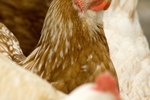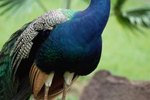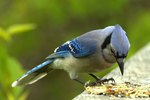
The savannas and deserts of Africa are home to the planet's largest bird, the ostrich, which unlike the majority of its avian brethren, is incapable of flight. These enormous birds, which generally grow to be taller than a human, are instead swift-footed, capable to breaking into a run at 43 miles an hour to elude a predator. Ostriches can live up to 40 years in the wild.
Physical Characteristics
A male ostrich can be anywhere between almost seven to nine feet tall and weigh more than 300 pounds. Females, or hens, are considerably smaller; their maximum height is approximately a little over si feet and they generally weigh up to 220 pounds. Males have a black plumage with white feathers on their tails and the tips of their wings; the female's feathers are light to grayish brown. An ostrich's wings help the bird maintain its balance and allow it steer itself while running. Sturdy legs culminate in two toes, one of which is a four-inch claw. The ostrich's eyes are approximately two inches wide, the largest of any terrestrial animal.
Diet
Ostriches are omnivores, which means they eat plants, as well as other animals. They have a hearty appetite for roots, in addition to leaves, seeds, berries and shrubs. Ostriches can forgo drinking water when they eat plant matter, which provides the hydration they need. When vegetation is not available, which is not unusual in the ostrichs' arid environment, they prey on insects, such as locusts, and even small lizards. At these times, they seek out water holes, where they congregate in groups of up to 700 individuals. In addition to their meals, ostriches will often swallow sand and stones, which aid their digestion.
Behavior
Ostriches are social animals that spend most of their lives in groups of up to 12 birds that are governed by a fairly rigid social structure. Herds typically consist of a dominant male, sometimes referred to as an alpha male, a dominant hen and several lesser females. Contrary to popular lore, ostriches do not bury their heads in sand. Rather, when they perceive danger and do not feel they have time to run away, they drop to the ground and lay their head and neck flat in order to blend into the sand or soil.
Reproduction
The complex social dynamic of ostriches is perhaps most apparent in their approach to reproduction. A herd's alpha male mates with the dominant hen and sometimes with subordinate hens, who may mate instead with vagrant males. All of the females in a herd lay their eggs together, but those of the dominant hen are invariably placed in the center of the pile in order to maximize their chances of hatching. The dominant hen incubates the eggs during the day, while the dominant male assumes the responsibility at night.
References
Photo Credits
-
Digital Vision./Digital Vision/Getty Images
Writer Bio
Since beginning her career as a professional journalist in 2007, Nathalie Alonso has covered a myriad of topics, including arts, culture and travel, for newspapers and magazines in New York City. She holds a B.A. in American Studies from Columbia University and lives in Queens with her two cats.




